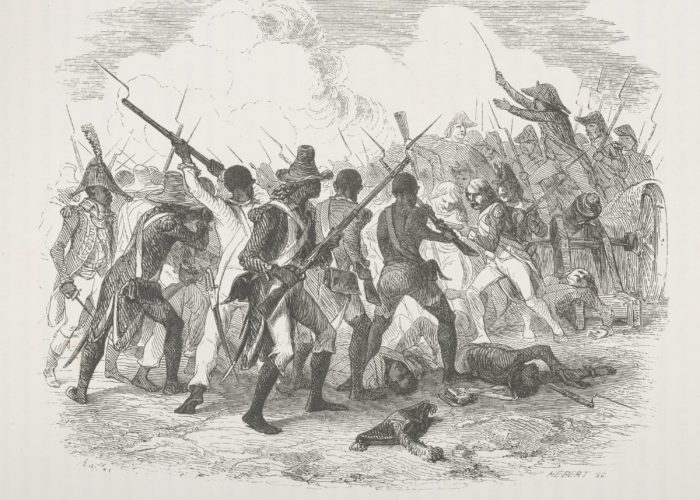The Battle of Vertières
Theme: The arts in the Age of Revolution, Haitian revolution (1791 - 1804), Challenging slavery: abolition and opposition, War and the international order
In the late 1700s, the western part (St. Domingue) of the Caribbean island of Hispaniola was under French colonial rule. It had long been a major centre of sugar production on plantations using enslaved African labour. In 1791, Toussaint Louverture led the first – and only – successful uprising of slaves, in St Domingue. After a series of bloody conflicts and traumas with European colonial powers, St Domingue was renamed Haïti and became the first independent Black republic in 1804. These events became known as the Haitian revolution and played an important role in the decline of the Transatlantic slave trade. This lithograph depicts the Battle of Vertières in 1803, the final engagement between Haiti’s revolutionaries and Napoleon’s French forces.
By 1803, Louverture was dead and Jean-Jacques Dessalines, one of his lieutenants, led the final bloody throes of the revolution. This lithograph shows the Haitians storming the French-held fort of Vertières. In the face of Dessalines’ assault, the French were forced to abandon it and, realising their position was now hopeless, they surrendered. St. Domingue had been the jewel in the crown of the French Empire, as it was the leading producer of sugar. Napoleon’s forces sought to reverse earlier upheavals which had resulted in the liberation of all the slaves in the colony. The loss of the island was a critical blow to Napoleon and forced him to focus his ambitions on building an empire away from the Americas and towards Europe.
In the image, the Haitian soldiers are dressed in a range of fashions, from European-style uniforms including an officer, resplendent in a feathered bicorn, to others adorned with straw hats and white shirts – a common sight on Caribbean plantations. In comparison, the French soldiers are clustered together, uniformly dressed with powdered hair. This reveals the way the conflict was viewed by the French at the time.
Traditional French revolutionary imagery tended to represent revolutionaries with their faces to the viewer, often bathed in light to convey heroism and evoke a sense of patriotism. In contrast, this image denies the Haitians the status of revolutionaries and focuses on the figure of the French officer defiantly standing on the rubble of the fort, as he faces his assailants. The officer looks out to the audience and is the focus within the lithograph which intends the viewer to regard the soldiers as heroic rather than the former slaves who were fighting to secure their independence and the ideological promises of the French Revolution.
Did you know..?
Originally inhabited by the Taino people, Christopher Columbus landed on Haiti in 1492 and named it Hispaniola. It became the site of the first permanent European settlement in the Americas.
Use our Classroom resources to investigate this object and the theme of Abolition further.
Highlights:
- Using objects, artworks and other sources to find out about the past
- Enquiry: Who fought for the abolition of the transatlantic slave trade and what were some of the tactics they used?
And much more…
Sources & acknowledgements
This object description and its related educational resources were researched and written by our team of historians and education specialists. For further information see the item’s home museum, gallery or archive, listed above.
-
Did you know..?
Originally inhabited by the Taino people, Christopher Columbus landed on Haiti in 1492 and named it Hispaniola. It became the site of the first permanent European settlement in the Americas.
-
Education overview
You can access a range of teachers resources related to this object and more on our education page.
Please also see our glossary of terms for more detailed explanations of the terms used.
-
Curatorial info
- Production Date: 1839
- Creator: August Rafette
- Original record
-
Use this image
- Rights Holder: © British Library Board
- License Type: All Rights Reserved



